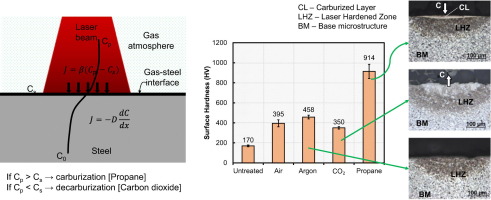Surface & Coatings Technology ( IF 5.3 ) Pub Date : 2020-01-25 , DOI: 10.1016/j.surfcoat.2020.125399 Niroj Maharjan , Wei Zhou , Naien Wu

|
Laser hardening is usually performed in air. Use of a controlled gas atmosphere might produce a direct reaction of the gas with surface and thus provide an opportunity to engineer the surface microstructures. However, few studies are reported on direct gas-assisted laser hardening process. In this paper, a direct gas-assisted laser hardening is demonstrated on AISI 1020 steel using an ytterbium-doped fiber laser in presence of four different gases – air, argon, carbon dioxide and propane. All hardening trials were conducted at same laser parameters and only the gas was changed to evaluate its effect on hardness and microstructure of the steel. Results show that argon had slightly higher hardening effect than air as it prevents surface oxidation. Propane produced a very high surface hardness (914 HV) compared to conventional laser hardening process (395 HV). The ultrahigh hardness is due to diffusion of carbon into steel from decomposed propane. Increasing the concentration of propane contributed to an increment in hardness primarily due to large amount of carbides in near surface region. Contrarily, carbon dioxide yielded a lower surface hardness (350 HV) despite its high carbon content. This is attributed to the oxidizing effect of carbon dioxide, which produces decarburization during laser processing. The study reveals the potential of using direct gas-assisted laser hardening technique to alter surface mechanical properties of steel.
中文翻译:

在可控气体气氛下对AISI 1020钢进行直接激光淬火
激光硬化通常在空气中进行。使用受控的气氛可能会产生气体与表面的直接反应,从而为工程表面微结构提供了机会。但是,关于直接气体辅助激光淬火工艺的报道很少。本文在AISI 1020钢上使用掺air光纤激光器在空气,氩气,二氧化碳和丙烷这四种不同气体的存在下演示了直接的气体辅助激光淬火。所有硬化试验均在相同的激光参数下进行,仅改变气体以评估其对钢硬度和显微组织的影响。结果表明,氩气比空气具有更高的硬化效果,因为它可以防止表面氧化。与传统的激光硬化工艺(395 HV)相比,丙烷产生了很高的表面硬度(914 HV)。超高硬度归因于碳从分解的丙烷扩散到钢中。丙烷浓度的增加主要是由于靠近表面区域的大量碳化物而导致硬度增加。相反,尽管碳含量高,但二氧化碳的表面硬度较低(350 HV)。这归因于二氧化碳的氧化作用,二氧化碳在激光加工过程中产生脱碳作用。这项研究揭示了使用直接气体辅助激光淬火技术来改变钢的表面机械性能的潜力。丙烷浓度的增加主要是由于靠近表面区域的大量碳化物而导致硬度增加。相反,尽管碳含量高,但二氧化碳的表面硬度较低(350 HV)。这归因于二氧化碳的氧化作用,二氧化碳在激光加工过程中产生脱碳作用。这项研究揭示了使用直接气体辅助激光淬火技术来改变钢的表面机械性能的潜力。丙烷浓度的增加主要是由于靠近表面区域的大量碳化物而导致硬度增加。相反,尽管碳含量高,但二氧化碳的表面硬度较低(350 HV)。这归因于二氧化碳的氧化作用,二氧化碳在激光加工过程中产生脱碳作用。这项研究揭示了使用直接气体辅助激光淬火技术来改变钢的表面机械性能的潜力。











































 京公网安备 11010802027423号
京公网安备 11010802027423号